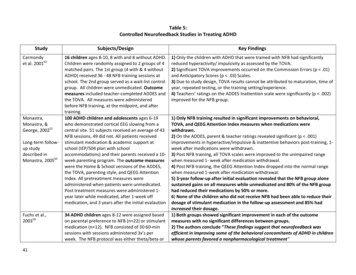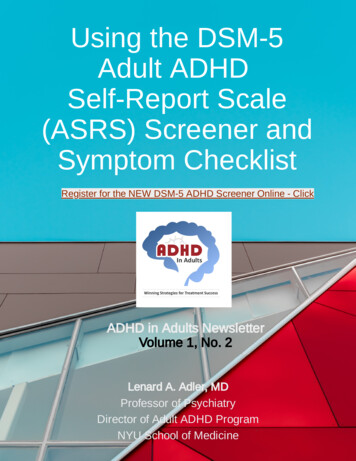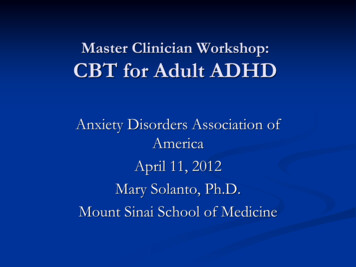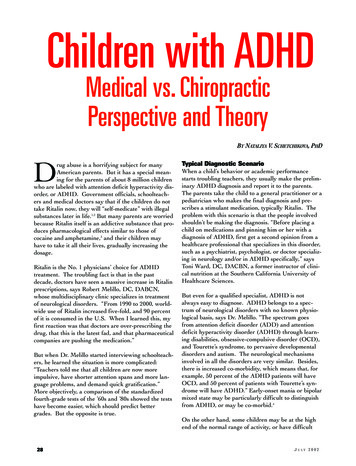
Transcription
Children with ADHDMedical vs. ChiropracticPerspective and TheoryBY NATALIYA V. SCHETCHIKOVA, PHDDrug abuse is a horrifying subject for manyAmerican parents. But it has a special meaning for the parents of about 8 million childrenwho are labeled with attention deficit hyperactivity disorder, or ADHD. Government officials, schoolteachers and medical doctors say that if the children do nottake Ritalin now, they will “self-medicate” with illegalsubstances later in life.1,2 But many parents are worriedbecause Ritalin itself is an addictive substance that produces pharmacological effects similar to those ofcocaine and amphetamine,3 and their children mayhave to take it all their lives, gradually increasing thedosage.Ritalin is the No. 1 physicians’ choice for ADHDtreatment. The troubling fact is that in the pastdecade, doctors have seen a massive increase in Ritalinprescriptions, says Robert Melillo, DC, DABCN,whose multidisciplinary clinic specializes in treatmentof neurological disorders. “From 1990 to 2000, worldwide use of Ritalin increased five-fold, and 90 percentof it is consumed in the U.S. When I learned this, myfirst reaction was that doctors are over-prescribing thedrug, that this is the latest fad, and that pharmaceuticalcompanies are pushing the medication.”But when Dr. Melillo started interviewing schoolteachers, he learned the situation is more complicated:“Teachers told me that all children are now moreimpulsive, have shorter attention spans and more language problems, and demand quick gratification.”More objectively, a comparison of the standardizedfourth-grade tests of the ’60s and ’80s showed the testshave become easier, which should predict bettergrades. But the opposite is true.Typical Diagnostic ScenarioWhen a child’s behavior or academic performancestarts troubling teachers, they usually make the preliminary ADHD diagnosis and report it to the parents.The parents take the child to a general practitioner or apediatrician who makes the final diagnosis and prescribes a stimulant medication, typically Ritalin. Theproblem with this scenario is that the people involvedshouldn’t be making the diagnosis. “Before placing achild on medications and pinning him or her with adiagnosis of ADHD, first get a second opinion from ahealthcare professional that specializes in this disorder,such as a psychiatrist, psychologist, or doctor specializing in neurology and/or in ADHD specifically,” saysToni Ward, DC, DACBN, a former instructor of clinical nutrition at the Southern California University ofHealthcare Sciences.But even for a qualified specialist, ADHD is notalways easy to diagnose. ADHD belongs to a spectrum of neurological disorders with no known physiological basis, says Dr. Melillo. “The spectrum goesfrom attention deficit disorder (ADD) and attentiondeficit hyperactivity disorder (ADHD) through learning disabilities, obsessive-compulsive disorder (OCD),and Tourette’s syndrome, to pervasive developmentaldisorders and autism. The neurological mechanismsinvolved in all the disorders are very similar. Besides,there is increased co-morbidity, which means that, forexample, 50 percent of the ADHD patients will haveOCD, and 50 percent of patients with Tourette’s syndrome will have ADHD.” Early-onset mania or bipolarmixed state may be particularly difficult to distinguishfrom ADHD, or may be co-morbid.4On the other hand, some children may be at the highend of the normal range of activity, or have difficult28J U LY 2 0 0 2
Children with ADHDtemperaments. Poor attention may also be caused byimpaired vision or hearing, seizures, head trauma,acute or chronic medical illness, poor nutrition, insufficient sleep, anxiety disorders or realistic fears, depression, or the sequelae of abuse or neglect. Variousdrugs (including phenobarbitol) may interfere withattention.4MisdiagnosisSimilar symptomatology and co-morbidity of conditions increase the possibility of misdiagnosis. ADHDis not a learning disability, but it can affect the abilityto progress in society and the ability to learn, saysFrederick Carrick, DC, PhD, DABCN, president ofthe ACA Council on Neurology. Many children aremisdiagnosed with ADHD “although they have learning disabilities, or receptive and expressive languageproblems,” says Joan Fallon, DC, FICCP, chair of theICA Pediatrics Council.Some children may simply have difficulty learning certain subjects, but schools often push to diagnose thechild with ADHD, says Scott Bautch, DC, DACBOH,immediate past president of the ACA Council onOccupational Health. “The higher the number of disabled kids in the school, the more funding the schoolgets. There have always been children who learn atdifferent speeds, but the ADHD diagnosis hasincreased because teachers are not tolerant of childrenwho learn things differently. But when children arelabeled with ADHD, the stigma stays with them.”Communication with the patient is the key to a correctdiagnosis, explains Dr. Bautch. “Ask the child and theparents about the frustrations the child has. Is he tooactive? Bored? Has dyslexia or a different learningpattern? We should understand the frustrations. Itcan be a behavior problem, problems at home, or frustrations with the teacher’s style. If the child is cognitive-visual—and the teacher is not—the child may simply not be taught in the way he can learn. If we wentto a conference where the speakers taught in a way wecan’t learn, we would be frustrated and would start tomisbehave—we’d get up and leave or chat to the person sitting next to us.”What Is ADHD?True ADHD is characterized by behavioral problemsin reacting to an average situation, says Dr. Carrick.“The diagnosis is based on the history of displayingthree types of behavior: inability to perform everyday tasks, or distractibility impairment to control impulses, or impulsivity restlessness, or hyperactivity.”JOURNALOF THEA M E R I C A N C H I R O P R A C T I C A S S O C I AT I O NEveryone will display those behaviors at times, so toclassify for the disorder, they have to be excessive,occur before the age of seven, last for at least sixmonths, and cause a problem in a social environment—at school or home, at work or in the marriage, saysDr. Carrick. Tracy Barnes, DC, DICCP, KentuckianaChildren’s Center board member, adds that if theschool is the only place where the child is acting up,the parents should see if there are problems with theschool. “Before taking your child to a psychiatrist, talkto a therapist or a counselor.”Every patient will display an individual combination ofthe three behavioral aspects, says Dr. Carrick.“ADHD is broken into subtypes—with predominantor non-dominant aspects depending on individuality,such as predominant inattention or predominant hyperactivity.” The range of symptoms will vary from onepatient to another and may include inability to concentrate and irritability, as well as confrontational, defiant,and oppositional behaviors, says Mark S. Smith, DC,DABCN.These oppositional behaviors are not actually the primary symptoms of the disorder, says Dr. Melillo.“Social non-verbal communication and interaction withpeople is a major problem for ADHD kids. They don’tpick up body messages, don’t understand personalspace. It’s hard for them to get jokes and the contextof speech. They understand what you say, but not howyou say it. As a result, they often become social outcasts, which leads to aggression and frustration.”The reason ADHD cannot be considered just a psychological problem is its functional presentations,Dr. Melillo says. There are motor signs—tics, tremors,and balance or postural problems. Soft neurologicalsigns, such as sensory integration deficits—unusualsensitivity to touch, movement, sights, or sounds—arealso present in ADHD children.ADHD MechanismBut how is the inability to focus and sit still connectedwith postural problems and sensory integration?Research shows that the link is in the brain.ADHD has been observed since 1938, saysDr. Carrick. “ADHD is caused by a problem with thereticular activating system—the attention center of thebrain. Its other functions include vision, hearing, andpreservation of older genetic traits.” By using a PET(positron emission tomography) scan, researchers canobserve the metabolic areas of the brain and comparethe brain structures in non-ADHD and ADHD individuals. “In patients with ADHD, certain areas of the29
Children with ADHDbrain are underfunctioning. It may be the cerebellum,the frontal lobes, or the right or left hemisphere,”Dr. Smith says. “Underfunctioning may be caused bytwo factors—“the level of stimulation of the brain orthe biochemical substrates to the brain. It means thatsome children have difficulty gathering and/or processing the information from the environment, some havebiochemical problems, and some have both,” heexplains.In view of the individuality of each patient’s ADHDmechanism, different disorder subtypes, co-morbidconditions, and functional deficits, the treatment, too,should be individual. “The severity of presentation ofthe symptoms will also vary, so the treatment that benefits one patient may not help another,” saysDr. Carrick.Medical Diagnosis and TreatmentThe traditional medical model, however, seems to follow the cookie-cutter principle. The very diagnosis ofADHD is based on the questionnaire laid out in theDSM-IV5 or other diagnostic manuals. If the child’sparents or teachers identify as positive six out of ninecriteria for inattention, or six out of nine criteria forhyperactivity and impulsivity, the child leaves the doctor’s office with a drug prescription and a new personality label. The patient is basically at the mercy of themedical doctor’s clinical experience—and 60 percent ofdoctors agree that there aren’t enough properly qualified ADHD diagnosticians.6The medical treatment also reflects the “one size fitsall” approach. Out of the three most commonly usedmedications for ADHD, Ritalin, or methylphenidate(MPH), is prescribed for more than 70 percent ofpatients.7 Although in many patients the disorder mayresult from the lack of brain stimulation, the medicalprofession leans toward developing the biochemicaltheory of ADHD—hence, the use of medications thataffect the level of dopamine in the brain.Dopamine is the main neurotransmitter in the “pleasure center” of the brain—a network of nerve cells thatmotivates much of human behavior. The pleasure center reinforces people’s drives to eat, drink, and procreate and is responsible for addiction. For example,when a person tastes ice cream, the sensors of thetongue signal the brain that it feels something, andneurons fire in the presynaptic terminal—the taste center of the brain. Dopamine is released into the synapsefrom the presynaptic terminal (the giving neuron), andthe receiving neuron (the postsynapse) takes it up.The receiving neuron, in turn, sends the signal toanother neuron by the same process. Through this30complicated network of signaling, the brain lets theperson know that an experience is pleasurable and isworth paying attention to.Dopamine is recycled by dopamine transporters—proteins that are embedded in the presynaptic terminalmembrane. When molecules of dopamine are floatingaround in the synapse, any that come in contact withthe transporters are sucked back into the presynapticneuron. A recent study8 showed that ADHD patientshave more dopamine transporters than people withoutthe disorder. This means that dopamine is not givenenough time to reach the postsynapse and instead istaken back into the presynaptic terminal. As a result,an inadequate number of dopamine molecules reachthe postsynapse and the neuron won’t send the reinforcing signal. MPH is called a reuptake inhibitor. Itblocks dopamine transporters and allows dopamine toreach the postsynapse and create a signal,9 improvingchildren’s ability to focus.Effects and Side EffectsBut Ritalin is not a cure for ADHD. The medicationneither corrects the disorder nor addresses the patient’sindividual problems. Eighty percent of hyperactivechildren have ADHD features in adolescence, and upto 65 percent maintain them in adulthood.4Medications merely control the symptoms of hyperactivity/impulsivity and even aggression, and allow children to concentrate better.10 Studies, conducted mostlyon 6- to 12-year-old children, show a 70 to 96 percentresponse to stimulant treatment, while the placeboresponse rate is 11 percent.11Effects associated with moderate doses of stimulantsare decreased appetite and insomnia. Negative effectson growth rate are possible, but ultimate heightappears not to be affected.1 Very high doses of psychostimulants, particularly of amphetamines, maycause central nervous system damage, cardiovasculardamage, hypertension, compulsive behaviors, and, incertain vulnerable individuals, movement disorders. Arare percentage of children and adults treated at highdoses have hallucinogenic responses. An animal studyof Ritalin has produced a “weak signal” that the drugmay potentially cause cancer.12 Other drugs used forADHD have their own adverse reactions: tricyclicantidepressants may induce cardiac arrhythmias,bupropion at high doses can cause seizures, and pemoline (Cylert) is associated with liver damage.13MPH cardiovascular effects include mild tachycardiaand blood pressure increase. Based on a report of sudden death in one child treated simultaneously withclonidine, the American Heart Association recomJ U LY 2 0 0 2
Children with ADHDmends a cardiovascular evaluation by a pediatric cardiologist before initiation of stimulant therapy.14Stimulant therapy is not recommended in patients witha history of tics or Tourette’s disorder, the presence of athought disorder, significant resistance to such medications in the patient or family, or insufficient severity ofthe symptoms or dysfunction.15Ritalin and Substance Abuseinhibitor than cocaine. A typical dose given to children—0.5mg/kg—blocked 70 percent of dopamine transporters,while cocaine blocks only 50 percent. People who tookMPH displayed high levels of extracellular dopamine—just as people using cocaine did.9 The only differencebetween the MPH and the cocaine effect on the brain is inthe way it is administered: MPH taken orally raisesdopamine in about an hour, whereasinhaled or injected cocaine hits the brainin seconds. Researchers speculate that“A recent studythe speed at which dopamine isshowed that Ritalin is increased is a key to the addictionprocess.9not a weak stimulant,Ritalin’s chemical properties cause themost serious concerns about its use.MPH is a schedule II narcotic thatbelongs in the amphetamine family ofstimulants and is regulated by the Drugas had been thought,Enforcement Agency (DEA) as a conIn 1999, approximately 9 million3trolled substance. Chronic exposure toAmericans used prescription drugs forbut is a more potentnon-medical purposes—to get high, tostimulants during development maytransporter inhibitorhave fun, to get a lift, or to calmchange the way the brain reacts to envidown.18 Ritalin abuse has beenronmental challenges, including stressthan cocaine.”reported among middle and highful events and pharmacological agents.school students. Some used it to supAnother concern is that long-term stimpress appetite or to stay awake whileulant administration in children mayalter the way the brain reacts to further exposure to stimu- studying. The DEA lists Ritalin as a “drug of concern”and reports that some abusers have dissolved thelants or other drugs with potential for abuse.16tablets in water and injected the mixture, which canA recent study17 showed that MPH is not a weak stimublock small blood vessels and damage the lungs andlant, as had been thought, but is a more potent transporter retina of the eye.18JOURNALOF THEA M E R I C A N C H I R O P R A C T I C A S S O C I AT I O N31
Children with ADHDGovernment resources for the general public declarethat, when taken as prescribed, Ritalin is notaddictive.19 The main problem is, there are no data ondosage response, and different children’s dosage needsvary.10 Dosage prescription, consequently, is guesswork. The common practice is, “Start low, graduallymove the dose up until you have reached maximal efficacy and/or run into side effects that are problematic,and then back off a bit.”10 Another problem is, the average physician gets little training in identifying drugabuse and may not recognize the warning signs.20A common tactic promoting the use of stimulants statesthat if a child with ADHD is not taking medication, heor she will “self-medicate” with illicit drugs later inlife.21 This theory has not been confirmed by research.No fully experimental studies (e.g., parallel groupswith random assignment, etc.) have been done in thisarea to date.7 The only two large epidemiological studies on the topic conflict. One reports more drug addiction in children with ADHD who took MPH, compared with children with ADHD who took no drug;22the other shows the opposite results.23 A major limitation of the research in the area is the inability to independently examine the use of stimulant medication, thediagnosis and severity of ADHD, and the effect ofcoexisting conditions.13 Some sources note, however,that it’s not the nature of ADHD itself, but the children’s social impairment,24 or difficulties adjusting insociety, that places them in the higher risk category forconduct problems, including substance abuse.16Consequently, the risk can be reduced by helping thechild build social skills.Increased Ritalin Use and Research NeedsDespite all the controversy surrounding its use, Ritalinprescriptions have dramatically increased in the pastdecade. During 1990-1993, ADHD outpatient visitsincreased from 1.6 to 4.2 million per year, while production of MPH in the United States rose from 1,784to 5,110 kg. More than 10 million MPH prescriptionswere written in 1996.7 Without uniform agreement ondiagnosis and treatment of the disorder, however, current programs are handled in a hit-or-miss fashion.One survey in four different communities found thatonly one-eighth of diagnosed ADHD children werebeing treated with stimulants,25 while another survey inrural North Carolina found one-third of the school-agechildren on stimulants did not meet diagnostic criteriafor ADHD.26A survey of Canadian doctors showed that 39 percentof doctors who treated ADHD felt pressured to prescribe MPH by teachers and 16 percent felt pressuredby parents. The majority of physicians agreed that32other factors responsible for the increased use of MPHare heightened public awareness of ADHD and itstreatments, a general increase in acceptance of medication as a treatment for ADHD, and a lack of resourcesfor other interventions.6Although stimulants have been given to children foryears and are considered the most widely researchedmedications children take, medical experts admit thatthe following areas have not been adequately studied:1. Treatment of ADHD, inattentive type, which mayinclude a large percentage of females.72. Stimulant treatment of preschool children.Despite a warning in the MPH package insert againstuse in preschoolers, and reports of higher rates ofadverse events in this age group, over 500,000 MPHprescriptions were written for preschoolers in 1998,7including two-year-old children.11 These numbers areespecially disturbing because the ADHD criteria ofhyperactivity, impulsivity, and inattention laid out inthe DSM-IV are common daily behaviors of mostpreschool-aged children.11 Because MPH acts primarilyvia the dopamine transporter protein, which undergoesactive development during the preschool years,increased prescribing for these children is of great concern.73. Safety information on sustained, long-term stimulant treatment (lasting longer than 14 months, eventhough current practice is to maintain drug treatmentin children for years).7 Medications remain the firstline treatment, despite a lack of adequate evidence oflong-term academic and functional improvements usingthis intervention.274. Tailoring treatments to children and outcomes.There is no research on the advantages of one stimulant medication over others. Doctors need an effectiveand comprehensive prescribing plan based on the characteristics of the child and family and tailored in termsof type, intensity, and frequency that would includerelating treatments to specific behaviors or componentsof ADHD, rather than the whole symptom complex.285. Treatment of ADHD in conjunction with coexisting conditions, including anxiety, depression, oppositional defiant disorder, conduct disorder, and learningdisabilities; how the conditions affect the effectivenessand safety of treatments.286. Development and evaluation of new treatments.Treatments that have more lasting and curative effectsare needed. Many children do not respond to stimulantmedications, or suffer severe side effects. Welldesigned rigorous studies of currently promoted butless well-established therapies such as occupationaltherapy, biofeedback, herbs, vitamins, and food supplements are needed. These interventions are not currently supported by evidence-based studies.28J U LY 2 0 0 2
Children with ADHD7. Epidemiology and etiology. Research on the etiology of ADHD (i.e., its biological and socioenvironmental causes) and its possible prevention is lacking.28Chiropractic Neurological ApproachThe medical treatment model seems especially limited inview of the recent discoveries in neurology. The 1990s—the so-called “Brain decade”—gave scientists insight intohow the neurological system works, says Dr. Smith.“Brains are not static entities. The brain grows—it hasplasticity, which is the basis of the ability to learn. If youstimulate the brain, it will cause plastic changes.”The identification of the underfunctioning hemisphere andthe monitoring of the patient’s response to the stimuli areespecially important. Our hemispheres are connected toopposite sides of our bodies, i.e., the left hemisphere controlsthe right side of the body. “Only stimulation of the side ofthe body opposite to the hemisphere with the decreasedbrain development will improve brain function,” says Dr.Melillo. “Manipu-lation on both sides will cause no change,but stimulation of the same side of the body as the hypofunctioning hemisphere will worsen the symptoms—byincreasing the function of the more developed hemisphereand creating more of an imbalance.”This theory has laid the foundaMoreover, chiropractic neurologicaltion for chiropractic neurologists“The medical treatment treatment modalities are often chosenwho, unlike other neurology spedepending on which hemisphere iscialists, treat patients withoutmodel seems especially less efficient, explains Dr. Melillo.medications or surgery.“We use different frequencies of lightlimited in view of the“Chiropractic neurologists areand sound because the right braintrained to identify the hypo-funcresponds to low frequencies and therecent discoveries intioning part of the brain andleft brain responds to higher frequenapply correct treatment modalitiescy stimulation. For example, theneurology.”to stimulate brain growth throughsense of smell affects the right side,plasticity,” says Dr. Smith. “Asespecially in boys, through the orbitalchiropractors, we identify subluxfrontal cortex. We also applyations and different sensory stimuli that specificallysomatosensory stimulation, vibration, muscle stretches, andaffect the deficient hemisphere and thus help normalize work with Tens units.”brain function.”Chiropractic neurologists closely focus on the individPatient examination is one of the most important stepsual functional difficulties their ADHD patients have,in the process, Dr. Carrick explains: “On every patient, Dr. Smith says. “Some children have a sequencingwe perform a comprehensive history and brain funcproblem—problems with planning, organization, andtion exam to identify what environmental stimuli maycoordination—so they can benefit from timing theracause changes in brain function. We use various highpies. They learn to clap or tap to the metronome—tech, but low-cost, diagnostic techniques that are verywith the hand or foot that goes to the deficient hemiaccurate and non-invasive. We test reflexes, such assphere. Spinning and balancing exercises are veryvisual and auditory, through optokinetic testing, andeffective—as well as adjustments. We may also useinfrared photography of the eye.”visual-motor exercises—targeting (such as throwingdarts at a board, coordination exercises), and cognitiveIn all the spectrum of neurological conditions, similartasks (such as crossword puzzles or mazes).”areas of the brain stem are affected, yet children showdifferent symptoms, says Dr. Melillo. “Detecting whichThe key to quick rehabilitation is frequent stimulationhemisphere is not developing quickly enough is the key.for a short time, says Dr. Melillo, so patients should doFor example, the right-brain areas are responsible for the some procedures at home. “Sometimes we use specialability to focus attention, visual-spatial orientation, readglasses that flash light in either the right or left eye anding comprehension, and social non-verbal communicablock the remaining field of vision—or get patients totion. The left hemisphere controls verbal communicasmell some things throughout the day. Adult patientstion,” he says. If the tests show that one side of the brain can use the Tens unit at home—for short periods ofis less efficient than the other, the doctor stimulates thetime three times a day. But the doctor should alwayshemisphere by evoking environmental potential: light,consider how much the patients’ joints and muscles cansound, heat, cold, or mechanical stimulation, such astake so as not to overstimulate them.”exercise or adjustment of certain body regions. “Thenwe will replicate the diagnostic criteria and see if there isAlthough currently no studies comparing chiropractica change,” explains Dr. Carrick.neurological and medical treatment for ADHD areavailable, the Carrick Institute is compiling the data.JOURNALOF THEA M E R I C A N C H I R O P R A C T I C A S S O C I AT I O N33
Children with ADHDChildren undergoing neurological treatment are giventhe Wyatte test—an individual achievement test evaluating reading comprehension, math, vocabulary, andreasoning. “We test children before they start the treatment and then every three months,” says Dr. Melillo.“Within the first three months, the children get a twograde-level increase on average—which is pretty dramatic. With children on medications, the improvementin academic performance is short term, and when theyare taken off the medication, the problems come back.Medications don’t affect the underlying problem. Ourprograms change the brain function and the academicperformance.”you will improve the opposite. Musculoskeletal imbalance will create imbalance of brain activity, and onepart of the brain will develop faster than the other.”ADHD and Chiropractic TheoryBut the effectiveness of chiropractic with ADHD children needs to be confirmed by research studies, says Dr.Fallon. “From clinical practice, we know that if patientswith ADHD—especially the ones with sensory integration issues—do not receive chiropractic care, they miss abig part of the treatment plan. Chiropractic care is consistent with physiology, and adjustments can help greatly.Besides, doctors of chiropractic spend more time withkids, see them in a different context, and may identifythose who receive unnecessary medical treatment.”Recent studies indicate that the ability to think is theevolutionary development of the ability to move.29 Thisconcept explains the effectiveness of chiropractic neurological treatment with ADHD patients, saysDr. Melillo. “Motor activity—especially developmentof the postural muscles—is the baseline function ofbrain activity. Anything affecting postural muscles willconsequently influence brain development. If youimprove either the movement or the cognitive ability,34This theory explains the effects of adjustments thatDCs have observed for years. “We have long knownthat one adjustment can affect many functions,” saysDr. Melillo, “because adjustment changes the brainfunction—and, depending on the individual, affects different symptoms in the body, for example, the ability tohear. Our hearing is controlled by the brain, not bythe ear—so through adjustments, we are affecting thebrain’s ability to process auditory information.”J U LY 2 0 0 2
Children with ADHDChiropractic patient assessment not only aims at subluxation detection, but also identifies patients’ individual symptoms. “Symptomatology must be globallyevaluated,” says Dr. Doscher. “Reading problems atthe age of 6 or 8 mean disorganization of the body, anda lack of communication between the two body sides.Check the vision and see if there is any divergence.Children may have auditory problems—when theycan’t perceive the sounds, localize them, or are hypersensitive to them. Check the child’s tactility—see if helikes to touch and be touched, or not. If a child can’tcreep or crawl and has to roll instead, it’s a sign. Is thelanguage clear? Is the child clumsy? Has troubledressing? Put the child on the belly and see if he canlift the head up, look in both directions, do the armycrawl, and lift the opposite arm and leg.”The success of chiropractic treatment is not only in thedrugless treatment modalities, but in the holisticapproach to treatment. “The medical treatment modelis based on the diagnosis, i.e., the name that is given tothe patient’s condition,” says Julie Bjornson, DC, secretary of the ACA Council on Neurology. “After that,the name is treated, not the patient. But DCs enhancethe function of the body by removing the interferenceto the body’s natural self-healing capabilities expressedthrough the nervous system.”Many neurological conditions, and ADHD in particular, are truly displaying the premise of chiropractic—subluxation. Subluxation can include imbalance ofmuscle tone
tain subjects, but schools often push to diagnose the child with ADHD, says Scott Bautch, DC, DACBOH, immediate past president of the ACA Council on Occupational Health. "The higher the number of dis-abled kids in the school, the more funding the school gets. There have always been children who learn at different speeds, but the ADHD .

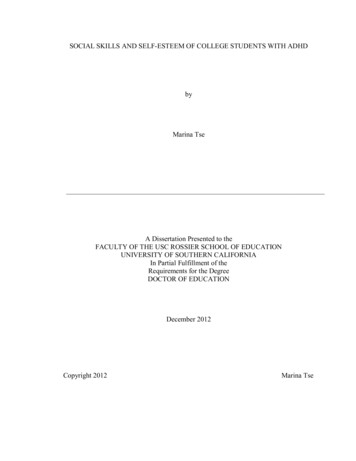
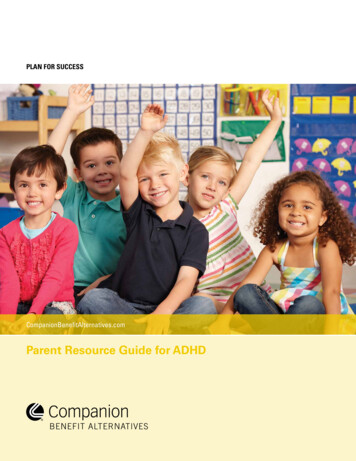
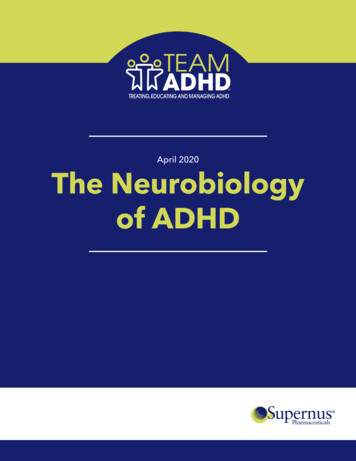
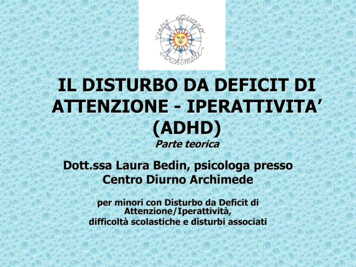

![Index [beckassets.blob.core.windows ]](/img/66/30639857-1119689333-14.jpg)
